Grandparents, Spouses, Partners, & Caregivers: Getting Others on Board with BLW
- How to deal with people in your inner circle who aren't entirely on board with baby-led weaning (yet 😜): grandparents, spouses and partners
- Why it's important to get comfortable feeding your baby FIRST before you invite someone else into your feeding environment
- Tips for staying focused on your goal: raising an independent eater...and not getting distracted by the mess or even how much your baby is (or isn't) eating

LISTEN TO THIS EPISODE
Episode Description
Are you the only one who believes in baby-led weaning? What if someone else feeds your baby and doesn’t want to do BLW? In this episode I share 2 mom’s stories of how they are dealing with getting grandmothers on board with BLW.

Link from This Episode
- Program: Baby-Led Weaning with Katie Ferraro program with the 100 First Foods™ Daily Meal Plan, join here: https://babyledweaning.co/program
- Baby-Led Weaning for Beginners free online workshop with 100 First Foods™ list to all attendees, register here: https://babyledweaning.co/baby-led-weaning-for-beginners
Other Episodes Related to this Topic
- Episode 53 - Explaining Baby-Led Weaning to a Skeptic: 10 Benefits of Baby-Led Weaning
- Episode 237 - Getting Grandparents on Board: Baby-Led Weaning Across Generations
- Episode 331 - Interviewing my Mom: How She Didn’t Like BLW at First & Why She Changed
Resources and Research
- Brown A. (2018). No difference in self-reported frequency of choking between infants introduced to solid foods using a baby-led weaning or traditional spoon-feeding approach. Journal of human nutrition and dietetics : the official journal of the British Dietetic Association, 31(4), 496–504
- Cameron, S. L., Taylor, R. W., & Heath, A. L. (2015). Development and pilot testing of Baby-Led Introduction to SolidS--a version of Baby-Led Weaning modified to address concerns about iron deficiency, growth faltering and choking. BMC pediatrics, 15, 99.
- Correia, Lia et al. “Complementary feeding approaches and risk of choking: A systematic review.” Journal of pediatric gastroenterology and nutrition, 10.1002/jpn3.12298. 27 Jun. 2024.
- Fangupo, L. J., Heath, A. M., Williams, S. M., Erickson Williams, L. W., Morison, B. J., Fleming, E. A., Taylor, B. J., Wheeler, B. J., & Taylor, R. W. (2016). A Baby-Led Approach to Eating Solids and Risk of Choking. Pediatrics, 138(4), e20160772.

Latest Episodes
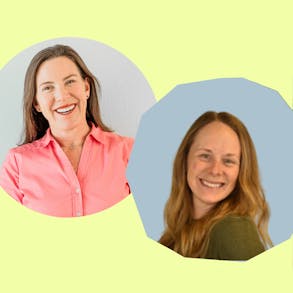
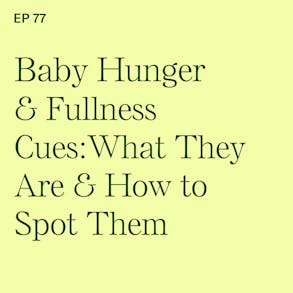
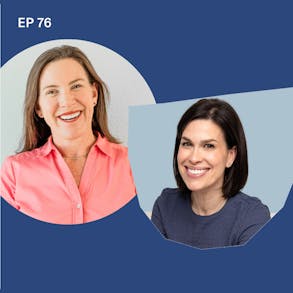
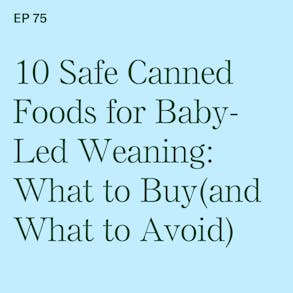
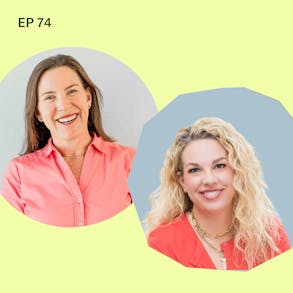
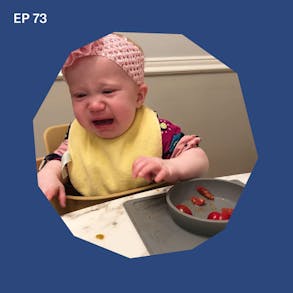
Katie Ferraro (0s):
So in this instance, grandma is concerned about the baby led weaning mess. And all she wants to do is get the most amount of food into the baby with the spoon. But that's not mom's goal. Yeah, mom's interested in minimizing the mess, but she wants her baby to learn how to become an independent eater and feed herself. And that's why she's doing baby-led weaning. Hey there, I'm Katie Ferraro, Registered Dietitian, college nutrition professor, and mama of seven specializing in baby led weaning. Here on the Baby-Led Weaning Made Easy podcast I help you strip out all of the noise and nonsense about feeding, leaving you with the competence and knowledge you need to give your baby a safe start to solid foods using baby led weaning.
Katie Ferraro (47s):
Hey guys, welcome back to another episode of the baby led weaning made easy podcast. This is your host, Katie Ferraro. I'm a registered dietician and a mom of seven specializing in baby led weaning. And I've got a different sort of episode for you today. Now this is a brand new podcast, and I think we need to cover the nerdy nutrition stuff and the developmental and feeding milestone things that are important to learn, to give our babies a safe start to solid foods. But I firmly believe there's also a psychological side of feeding that we too often don't address. And so today's episode is one that a lot of you guys requested it's about how to get others on board with baby led, weaning grandparents, spouses, partners, and caregivers.
Katie Ferraro (1m 34s):
How can we help them see the benefits of baby led weaning while at the same time, they're often the ones, times the ones helping us feed our babies and they have their own opinions about how a baby should be fed. So today's episode again is a little bit different than some of the other ones that you have heard on this podcast so far, but I want to share some stories in particular, two different moms stories. There's no one size fits all approach for how we deal with others who perhaps disagree with. Or as I like to say it, they don't quite see the benefits of baby led weaning yet. How do we talk to those people? We of course want to be respectful.
Katie Ferraro (2m 14s):
We want to be educated, but we want, we don't want to come across as defensive, but also we want to defend our decisions in how we've decided to feed our babies. So today's episode is dedicated to all of you who may be struggling with getting others on board with baby led weaning. And I want to share the stories of two moms who graciously shared their stories with me about what they're currently going through. Nobody has the right answer, but maybe some of these techniques and these tips, and maybe even some of the language that they're using, you can glean bits and pieces of it that will work for your own situation. It's none of us are in the same situation. Many parents are perhaps staying home more than they intended to, or they may have to go back to work earlier than they thought, or their baby's not progressing as fast.
Katie Ferraro (3m 1s):
And they're worried about daycare not being able to safely do baby led weaning. So with no further ado, then I just want to go ahead and tell you the story of two moms. The first one is coming from Naomi. Now I've been watching Naomi's baby eats since she started solids with six months of age. And she said, initially she reached out and we were talking about, she felt like she was getting criticism from her family because they all think that the baby needs to start with purees. And that I shouldn't be giving her finger foods yet. And like any mom Naomi saying, I want to do what's best for my baby, but I'm still not sure if I'm doing this correctly because she's not eating much yet. And then the family inevitably says, well, you should just go back to spoonfeeding purees.
Katie Ferraro (3m 42s):
That's the way to get her to eat a lot. So she says, I don't want to give up yet. And she said, thank you for your videos and your podcast and your posts that helps me tremendously with anxiety about starting baby led weaning and gives me hope that one day my baby will eat like a champ, despite what other people say. And then she sent me this beautiful video of her daughter on her first day of baby led weaning. I wouldn't even call it eating with licking, a piece of cooked broccoli. And I was like, this is beautiful. Like your babies don't eat very much at the beginning. If you've listened to any of the other episodes, I hope that that's the takeaway message. You are not doing anything wrong. If your baby does not eat a head of broccoli on day, one of baby led weaning, but this baby is smelling it and sniffing it and smashing it and smiling, sitting in her high chair at six months of age and Naomi, the mom said, I hated broccoli as a child.
Katie Ferraro (4m 31s):
So I think it's amazing that she overcame a fear of a food she doesn't like and offered it to her daughter. So as we started talking about, okay, well, you know, tell me more about your family situation and what's going on. So I'm just going to read Naomi's words about her daughter, who again now is six months of age. So she said at the beginning, everyone questioned why didn't I start giving my baby rice cereal around four to five months. I told them that I'm going to start her on baby led weaning around six months. My mom helped me to take care of my baby when I went to work. But at the time of this recording it's during the COVID quarantine due to the COVID situation, I've been home, but I go back and forth to my parents' house over the weekend. So I love this. My mom doesn't really go against me doing baby led weaning.
Katie Ferraro (5m 13s):
And I know some of you guys deal with moms or mothers in law who just do whatever they want to, and that's your own cross to bear. But she said, she just thinks it's more efficient. If we spoonfeed her, I tried to explain to grandma what I'm trying to do. And the purpose of baby led weaning. So she's somewhat onboard with me when I was out and she helped me feeding the baby. I could see her trying baby led weaning, but she got frustrated because the baby made a mess. So she ended up spoonfeeding her. And I honestly couldn't really stop her doing that. I would just tell her that eventually my daughter will get better at eating because I want her to be an independent eater. So I want to unpack a little bit about what Naomi is saying here. So much of this, I hope is resonating with those of you.
Katie Ferraro (5m 55s):
Some of you are like, no, man. My whole tribe is on board with baby led weaning. Then this is probably not the episode for you, but I hope what a lot of you are hearing is some of them, the fears about baby led weaning for grandparents, it's always going to be the mess. Like, you know, they stress out when the baby like takes two toys out of place when you're at their house. Like it is stressful to bring your messy baby into somebody else's house. I get that. And I will not argue that baby led weaning. Yeah, it's messy. Now I would also argue that, you know, traditional spoonfeeding can be messy as well. And what was cool is Naomi sent me some pictures of her mom feeding the baby. And it was the traditional, like she was using a baby led weaning spoon, putting look like oatmeal in the baby's mouth and then a little bit with drip out and then scooping up a lot of the oatmeal from around the baby's mouth.
Katie Ferraro (6m 40s):
So the baby gets a taste of it. Yeah, this is cool. And then the next three interactions with the spoon are the spoons scraping the food off of her mouth and from around her mouth rather and back into her mouth. And you know, Naomi was like, it's fine. It's not the end of the world. A lot of babies have been spoonfed and they live together all about it. Right. But I liked that. She pointed out that she thinks it's just more efficient. If we spoonfeed her, correct. You can take a pouch and squeeze it into a baby's mouth with minimal mess. But just because we can do something doesn't necessarily mean that we should. If the goal is to help the baby become an independent eater, we're doing no good deeds for the baby by squeezing X amount of a puree into their mouth or shoveling it in with a spoon.
Katie Ferraro (7m 26s):
So yes, it may be more efficient, but I think what might be helpful for Naomi in this situation is to take a step back and analyze what's the goal is the goal to completely prevent the mess at grandma's house. It might be okay, and that you have to live with grandma's rules and you guys have to deal with your moms and mothers and laws as you would, and to other people in your community. But I would say for me, and I try to help parents understand that to raise an independent eater. The goal is not to prevent the mess. We can do things to minimize mess, okay? But we're not here to prevent the mess. We're here to allow the baby the opportunity to learn how to eat. So I understand Naomi's pickle. It's like my mom is helping me so I can go back to work.
Katie Ferraro (8m 7s):
She doesn't like the mess, but it's also more efficient. Okay. Well, if Naomi could learn to feed her Naomi's baby, rather Naomi can feed herself because she's the mom here. If the baby could learn to feed herself, the baby would actually become more efficient at getting the food in her mouth. And it will be less work for grandma down the road. Yes. At the beginning, the first few weeks, it looks like the baby's not eating much. And if I were Naomi, I'd do the same thing. Sure. You spoonfeed her. When you want to. When I'm at my house, I'm going to be offering soft, solid foods. Or if we do purees, it will be in a manner where the baby is allowed to feed the preloaded spoon by herself. Parents will often ask isn't it confusing for my baby though, if they get one type of texture at grandma's house and one type at my house, there's no hard and fast data that says that is a bad thing.
Katie Ferraro (8m 53s):
It's certainly not consistent. And when possible, we try to offer consistent feeding opportunities at meal times. But I also understand in real life, sometimes grandma's going to spoonfeed the baby. Now, if someone's always spoonfeeding the baby, the baby will be conditioned to expect someone to feed them on top of the fact that if someone's always feeding them, we're then taking away the baby's ability and desire to feed herself. So the other thing that I noticed in here was that the mess was a point of anxiety or a pain point for grandma. Certainly one thing that Naomi might be well to do is to provide personal protective equipment, which is basically what it is, but feeding gear that will minimize the mess and keep a set of that at grandma's house.
Katie Ferraro (9m 39s):
If you have to go to work and the baby goes to grandma's house, you know, it's annoying to pack everything in the bag, have a silicone suction mat or bowl that lives at grandma's house, have the type of spoons that you like buy the full coverage, bib that you like, and please get grandma a splash mat. So a splash mat is a large piece of material that goes underneath the baby's highchair. It serves two purposes. It helps make it easier to clean up at the end, which is good if grandma's not into cleaning up the mess, which she sounds like she's not. But it also, if the baby does drop food on the floor at the beginning, you can then recycle it back up off the floor, back onto the mat, which helps reduce waste because sometimes grandparents or other people perceive baby led weaning as well.
Katie Ferraro (10m 21s):
They drop it all on the floor, smeared everywhere, and they're wasting the food. It might help to also remind the grandmother or whoever else is helping you feed that babies are still getting most of their nutrition from breast milk or formula. So while yes, it's more efficient for grandma to scoop those little spoonfuls of oatmeal back up and push it into the baby's mouth. That's not the point here. The point, yeah. Feeding a baby at six months of age or allowing a baby to learn how to eat is just that giving the baby practice and time to learn how to eat so that in a few weeks she can more efficiently feed herself. Again, if we take away that baby's ability and desire to learn how to do that task, we can't expect the baby at eight months of age to know how to feed herself the oatmeal with the spoon, with minimal spillage.
Katie Ferraro (11m 5s):
If she hasn't been given the opportunity to practice. So one thing I always encourage parents, and I know it's not always possible in your real life situation, but is to get comfortable feeding your own baby a number of foods first, before you invite anyone else into the feeding spectrum of further on in our conversation. Naomi said that her husband fortunately is onboard with baby led weaning. I explained to him about it. He trusts me so far. He hasn't fed our daughter yet, but he happily saw me doing baby led weaning. And I like that approach. I have seven kids even with my last two Gus in Hannah, when I was doing baby led, weaning education full-time and had been for years, my husband would walk in the kitchen and be like, I don't think the babies can eat that.
Katie Ferraro (11m 47s):
And I'm always like, can you just please leave? Like I've said it at other episodes was like, do you even know what I do for a living? Like, yes, maybe we can eat that. But you being right here telling me that a baby can't stresses me out till no end. So I would like to get comfortable with the first three or four days of baby led weaning with my baby where I'm observing the gag. I'm not overreacting. I'm helping the baby through it. I'm offering them a variety of textures. I want to be the one that's in control. And I'm all about sharing responsibilities in a partnership in parenting. But there's some things I just want to do by myself and starting solid foods is one of them. Now, once the baby gets a few foods underneath her belt, then go to grandma's house. Don't try new food at grandma's house, bring familiar foods to grandma's house.
Katie Ferraro (12m 30s):
And just demonstrate when I do a meal at home, this is how I do it. Whether or not you say this is how I want you to do it. That might be implied. You might have to say that you might be like, Hey, maybe she'll just pick up on the fact that the baby can feed herself and realize down the road, it will be less work. There will not always be so much mess. So a couple of takeaways there, the goal is not to prevent mess. The goal is to help the baby learn to become an independent eater, getting comfortable with feeding your own baby first can do a world of good when you take a baby to another environment and they're like, oh, that baby actually can feed themselves because seeing really is believing. Right? And then one more thing that Naomi was sharing with me is that my sister-in-law who has two kids has been telling me that baby should start from the puree phase because there are steps before eating finger foods.
Katie Ferraro (13m 17s):
She said the baby's body will be shocked from progressing too fast. Like her poop might be hard or it might bleed. I told her the baby has been doing so well. The poop looks normal. Not really sure how to get her on board. And again, if that sister-in-law is not the one involved in directly feeding your baby, it's probably not important that you get her to see things your ways right off the bat, your way right off the bat in Naomi's case, I think it's more important that grandma gets a little bit more on board with allowing the baby to sell feed. Maybe that means more time where Naomi showing her exactly how she feeds the baby, how she sets her up, where you put the splash mat down. And if you guys are looking for a good splash mat recommendation, the bibs and the splash mats that I use and recommend for baby led weaning are from the company called Bapron baby.
Katie Ferraro (14m 1s):
So if you go to baker and baby.com, they make these Bapron bibs. They're like baby led weaning bibs or full coverage, bibs that tie behind your baby's shoulder blades, which is a much more comfortable sensory experience for the baby. Plus it covers a huge part of the baby's body to help prevent the mess from getting everywhere. And they use the same material in their splash mats, which go underneath the high chair. So Bapronbaby.com. You can get 20% or 10% off rather with the code, Katie 10, Katie one zero, and I'll link to the baby and baby products. As I think they're essential for getting a safe cleaner start to solid foods, to go to the show notes for this episode, it's BLWpodcast.com/ 22.
Katie Ferraro (14m 44s):
I'd also encourage you to buy additional bowls, spoons, and cups that you want the baby to use. That's important to be consistent. I like the tiny spoon from ezpz the tiny bowl from ezpz and the tiny cup. They having a product at ezpzfun.com called the first foods set. It has the tiny bowl. It has a two-pack of the tiny spoons and one of the tiny cups by grandma, that first food set. If you use the code, Katie 10 at easy-peasy fund.com, you can also get 10% off, buy an extra set that lives at grandma's house. And your mother-in-law mother will probably be happy to have additional feeding gear that is consistent with what the baby's having at home.
Katie Ferraro (15m 27s):
So I just wanted to say, thank you to Naomi for sharing her story. She's like this is a work in progress. Like let's pick our battles. We want the baby to be safe. She's offering a variety of foods at home. If grandma's helping, there are a few tweaks that she could make possibly sending the gear, sending the food already prepared, and then showing a few times a few meals with grandma, how you want the baby to be fed because seeing really is believing and knowing that, gosh, if I put the food on the spoon and give it to the baby, a baby can do so much more than we sometimes give them credit for, but we sometimes have to see it to believe it. So thank you for sharing your story. And then she sent me like a million cute videos. I'm going to ask her if I can link to them and show notes. I haven't done it yet, but this baby is adorable and they're figuring it out, right?
Katie Ferraro (16m 12s):
Nobody is born knowing how to do all of this stuff. We're all learning together. So thank you for sharing your story. I have one other story I want to share with you. This is so cool because this is a little bit of a different family situation. The babies that the mom, just for the sake of anonymity, I don't want to say the, the, their handle or anything. If the parents say it's okay to share, I'll do so in the show notes. But these are parents that I reached out to who had asked for an episode, particularly about grandparents and how to get them on board. And we'll do a separate episode on daycare because your relationship with a daycare provider who frankly, you are paying to do things the way you ask them to do is different than your relationship with your mother.
Katie Ferraro (16m 55s):
Who's probably watching your child for free. And again, taking the money side out of it. Maybe some of you pay your moms to watch your babies, which you know, you do you, but like nannies caregivers. I have slightly different suggestions because again, you're sometimes not asking in that regard, you're telling how you want your baby to be taken care of. But I know a lot of us are like not in a position to tell our moms how we want the babies to eat. And I always share my own story of my own mother. Who's also a dietician who did traditional spoonfeeding with all of us. She's like, I think this is ridiculous. At first, like I spoonfed all six of you kids, and you're fine. None of you have weird relationships with food. You're all healthy. And like, yes, there are many children who were traditionally spoonfed, who, as I say, live to tell about it.
Katie Ferraro (17m 37s):
But when I started doing baby led weaning with my quadruplets, she was not entirely supportive. She wasn't negative, but I just chose to not have anyone who's not entirely supportive of my situation, helping me feed the babies. So it took a for me to get the confidence, to do solid foods with my babies in front of my mom. And I remember the day I caught her bragging on the phone to her friend about my quadruplet daughter, Claire eating sardines and beets. And I was like, oh mom, I thought you were on board with this stuff. She's like, oh my gosh, it's amazing. And to this day we have 20 grandkids. We spent a lot of time with our cousins together. Some of whom are better eaters than others. And my mom will be like, I would rarely give you credit for things, but this whole baby led weaning thing. Like your kids will literally eat anything.
Katie Ferraro (18m 19s):
And they're so incredibly independent. But the caveat there with toddlers though, I think a huge success for us is just not eating a lot of snacks. We're an almost snack free household. I will share with you all of my opinions, research findings regarding babies and snacks, but grandparents are notorious for feeding babies, tons of snacks, and then complaining that they don't eat dinner. So I feel like I've at least trained my mom in that regard. Thank you again, Naomi, for sharing your story, I've got one more for you guys. This is a cool situation. So mom is American. She's from Colorado. Dad is British. They live in England. Dad's mom was a pediatric dietician for many years.
Katie Ferraro (18m 59s):
So this particular mom and her daughter and her husband, they live in the UK. And so the parents used to always tell a story. The parents, both of the parents were traditionally spoonfed, traditionally weaned. And this particular mom and her husband, she said, they're big foodies. They're determined to give their daughter the best chance to be one as well. And so her husband's parents always tell a story about how one time the baby was nine months old and he grabbed some steak off their plate and started eating it. And they thought it was amazing. So he said, you can't imagine their astonishment. They see our little girl eat lamb and beef and all the other family foods starting at six months of age, the mom's parents live in Colorado, but they're in the UK.
Katie Ferraro (19m 46s):
And she said, I was video chatting with my mom this week. The baby was eating some toast with peanut butter, thinly spread on it. She had a very small gag and my mom's instant reaction was, oh my God, she's choking. I stayed very calm. I gave the baby, you were sharing hand on her. As I knew, she knew exactly what to do. She basically talked her out of it. And so the baby recovered, my mom just said, so I guess that's just part of her learning how to eat. And I think that's so cool. First of all, that they're like video chatting and you can see across the globe, your child learning or your God grandchild, rather learning how to eat. And that mom maintains the ability to video chat, feed foods and stay calm when the baby is gagging, which is also, moms are amazing.
Katie Ferraro (20m 27s):
But she went on to say, I truly believe that the best way to get family members or anyone else for that matter is to show them. I can't see my family every day right now, but I send them videos every day of their granddaughter trying new foods. My husband's mom keeps saying how amazing it is to see how it challenges everything she was taught during her work. And as a fellow dietician, I fully feel that because so often, I mean, I teach nutrition throughout the life cycle at the college level and have for almost 20 years. And it's amazing that we don't even have in our curriculum, a mention of the fact that babies can feed themselves. Now, I mentioned it in my curriculum, but my colleagues, we don't learn anything about baby led weaning, and think it's why it's so important that the work that baby led weaning researchers are doing that continues to be published that supports this baby led approach to feeding, seeing is one thing.
Katie Ferraro (21m 20s):
But peer review published research is another thing. And I think the combination of those two things with the advent of social media and seeing that there are different ways to feed a baby and then to have an established credentials, professional, a pediatric dietician who did this for years say, gosh, maybe there is a different way for a baby to learn how to eat and to be open to that. And it's so crazy because when we first started talking about this, this particular mom, mom was like, I'm concerned my family's not on board. And she told me her story. I'm like, oh, your family is definitely on board. But seeing is believing, I think is really key and getting comfortable with feeding your own baby first, even perhaps before you involve your caregiver or your partner rather be something that helps you through what can be a difficult whole time.
Katie Ferraro (22m 3s):
But I just bring this episode to you, hopefully remind you that there's no right or wrong way to feel the baby. You do what is comfortable for you, but please no that your baby who is six months of age can and wants to feed himself or herself. And I always try to bring it back to Ellyn satter's division of responsibility in feeding theory, which is you guys as parents, we have a job which is to offer our babies. We're in charge of what they eat and when they eat and where they eat, right? We have to offer wholesome foods. It's at mealtimes in a safe space, meaning a high chair with a flat foot rest. But it's the baby's job to determine how much or even whether they eat.
Katie Ferraro (22m 46s):
And so if we can remember that our job first as the primary caregiver, the one who's probably setting the stage for how this baby will eat. It's our job to determine who is job is what right? You take the trash out. I do the dishes. I'm in charge, not the baby, you know, with your spouse, your caregiver, et cetera. I'm in charge of what and when and where the baby. But I have to let the baby do their job, which is citing how much or even whether they eat. So in Naomi's case when she was saying, oh, but my mom says it's more efficient. If the goal is to get the baby eat X amount of calories or grams or ounces, then yes, it would be more efficient. But if we're letting the baby do their job, we have to allow the baby the opportunity to feed themselves the opportunity to decide what there are, they're going to eat, or how much they're going to eat.
Katie Ferraro (23m 31s):
The first few weeks are Rocky. I'll give you that much. Both of them, moms who shared their story today, their babies are Naomi's baby is just starting out. So she's before that, like I call it the eight month click, like where everything clicks she's before that period, I guarantee you at eight months of age, when Naomi's baby is eating sardines and beets, grandma's going to be a grateful that she doesn't have to clean up. Well, okay. Beets are messy. That's a bad example. Oh, and I do just want to say she had mentioned poop. You guys will see a little bit of the food and your baby's poop and that's fine. That is not an indicator that your baby can not digest food. Your baby's digestive tract is actually fully matured by the three month mark to handle and digest and process any of the nutrients from foods that adults eat.
Katie Ferraro (24m 15s):
It's just that their gut is learning how to process that still so they can handle it, but they're still in the learning mode. So don't freak out if you see stuff in the stool. And I mentioned that with beets, because with beets, the poop looks like there's blood in it and you freak out. That's just beets. That's normal. Okay. With asparagus, the pee is going to smell really bad. Like there are some bodily changes that occur, but it's not a sign that something is wrong. So in summary, I hope some of their stories were helpful. Naomi, with a six month old baby, it hasn't all clicked yet. Don't give up on offering your baby a variety of foods because you're giving her the opportunity to practice by eight months. I bet grandma and even sister-in-law is going to be on board with that one. And then for the other mom, who's based in the UK, that baby's nine months of age.
Katie Ferraro (24m 56s):
She's kind of already enjoying the fruits of her labor, which is now she gets to like regularly send videos and pictures of her daughter eating a whole variety of foods and grandma overseas and back in the U S is like, wow, okay. This is just a different way for a baby learning how to eat. And then grandma back in the UK, who's a pediatric dietician for her whole career is like, Hey, this is also just a different way for a baby to eat neither way being right or wrong. But your baby who is six months of age, just so you know, has the ability to feed himself or herself. So thank you guys for these great ideas for the topics for the podcast episodes. Rather thank you for sharing your stories. Thank you for sharing. Not only just your wins, but also the difficult points along the way, because I think it's nice to hear, gosh, not every baby wakes up on their six month birthday and magically knows how to eat foods.
Katie Ferraro (25m 46s):
And as much as I love social media for sharing knowledge and the actual visual part of babies, learning how to eat and being able to eat sometimes that comes at the risk of parents, mistakenly comparing their babies to someone else's babies. So as we say in the business world, you know, compare and despair, you cannot compare yourself to anyone else as business. You cannot compare yourself to anyone else's baby, a six and a half month old baby may be able to feed themselves. Whereas their identical twin may need a few more weeks to get that skillset together. Just today I had in one of my membership groups, three different moms of seven month old babies, two of the moms were at the stage where the baby was like, not really interested in food, still spitting the food out, kind of playing with it.
Katie Ferraro (26m 30s):
What is the point of this? I had been doing this for four weeks, two times a day. They're not really eating anything. Another mom with a baby, almost the same age as like you guys the last day or two, it clicked for my baby. I'm a little, baby's maybe a little ahead of schedule, but now the baby's starting to bring the food to our mouth, starting to eat it a little bit happier at mealtime. All babies will develop on slightly different timeframes. So please don't stress yourself out. If you see other six and a half month old babies and your babies that age and your baby's not eating as much, put your head down, do the work, offer the safe space for your baby to eat, offer the wholesome foods, give them established mealtimes and the opportunity to practice. And I promise you it will all click. And then all those naysayers, they will eventually see things your way with regard to baby led weaning.
Katie Ferraro (27m 15s):
So hang in there, you guys are doing an awesome job. Bye now!
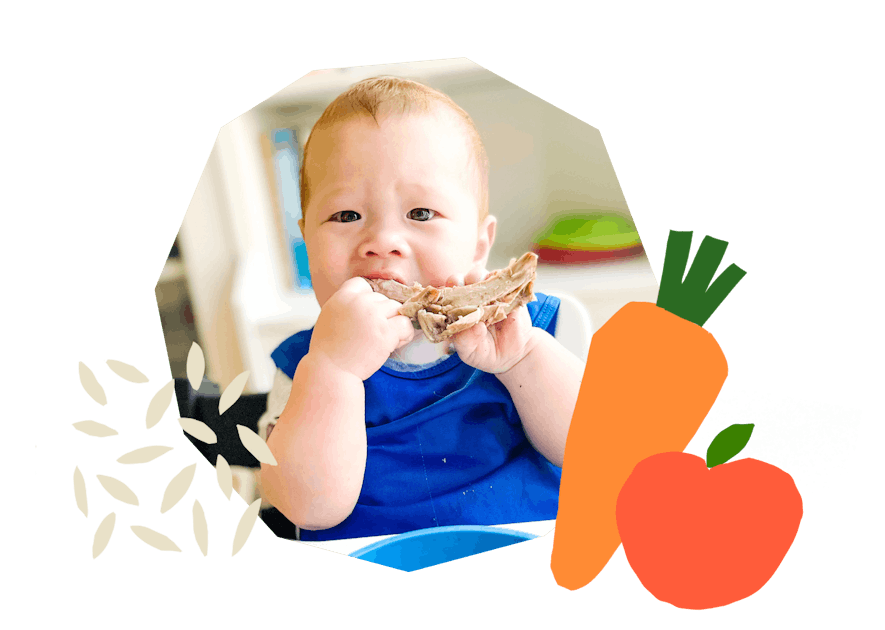
The Program Baby-Led Weaning with Katie Ferraro
A step-by-step digital program for starting solid foods safely and navigating the original 100 FIRST FOODS™ meal plan with baby-led weaning.
 EXPERT-LED, PROVEN APPROACH TO EATING REAL FOOD
EXPERT-LED, PROVEN APPROACH TO EATING REAL FOOD CONCISE VIDEO TRAININGS TO MASTER BABY-LED WEANING
CONCISE VIDEO TRAININGS TO MASTER BABY-LED WEANING 100 FIRST FOODS DAILY MEAL PLAN WITH FOOD PREP VIDEOS
100 FIRST FOODS DAILY MEAL PLAN WITH FOOD PREP VIDEOS
Baby-Led Weaning for Beginners Free Workshop
Is your baby ready to start solid foods, but you’re not sure where to start? Get ready to give your baby a solid foundation to a lifetime of loving real food…even if you’re feeling overwhelmed or confused about this next stage of infant feeding.
Get baby-led weaning recipes and tips delivered to your email inbox.

